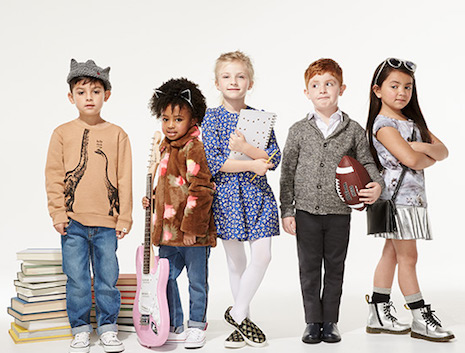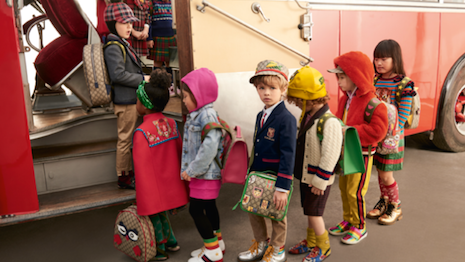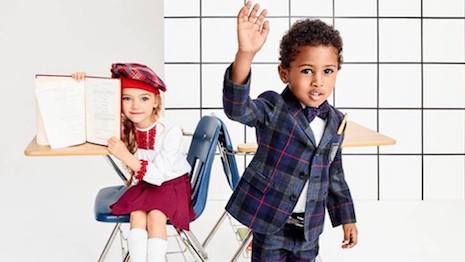As students prepare to head back to the classroom, rising consumer confidence has created a growing market for back-to-school shopping.
In the U.S. alone, consumers are expected to purchase $83.6 billion worth of back-to-school items, marking the second-highest spending level on record, according to statistics from the National Retail Federation. However, even with the potential that exists around this shopping season, most luxury brands have neglected to promote their back-to-school ready items to students and their parents.
"There are two main drivers of this trend: the growth of ecommerce and the on-trend influencer marketing space," said Naomi Davidowitz, chief customer officer at Crowdtap, New York. "Both have converged at the right time for back-to-school shoppers. Parents, and empowered kids, are consuming content and are influenced at all hours of the day with check out now options only one click away.
"Visits to mass retailers are also increasing. This speaks to the millennial parent seeking to be involved and turn this annual tradition into an experience for their child/children.
"With all this said, luxury brands should take advantage of the experiential shopper and offer customization every step of the way, from the niche influencer targeting their consumer's passions to offering their shoppers custom options that will help them stand out among their peers. Brands should be testing every preference, option, assumption - a robust combination like that needs to be backed by data."
Head of the class
According to NRF, back-to-school shopping will be up more than 10 percent from last year.
Apparel and accessories are only a piece of the total spend, but parents still anticipate shelling out $10.2 billion on clothing. The 95 percent who plan to buy clothes for their children will spend an average $239 on attire.
About two-thirds of parents say their back-to-school purchases will be influenced by their children. This influence appears to be growing, as only 57 percent said the same last year.

Image from Neiman Marcus back-to-school email campaign. Image credit: Neiman Marcus
Department stores are the most popular destination for back-to-school shopping, with 57 percent of shoppers headed to bricks-and-mortar retailers. Ecommerce, however, is not too far behind with 46 percent buying online.
Deloitte’s 2017 back-to-school survey found that online channels also hold sway before point of sale. More than half conduct research online before making a purchase, and about a quarter turn to social media to make decisions on what to buy.
With digital channels a main point of research for luxury consumers, brands including Gucci, Neiman Marcus and Oscar de la Renta have all reached out to these shoppers via digital campaigns.
A dedicated email from Gucci linked to a catalog of apparel and accessories for the littlest clients. The brand featured everything from sneakers, tops and jeans to backpacks embellished with cartoon astronaut cats in editorial imagery of kids on a bus.

Image from Gucci's back to school catalog. Image credit: Gucci
Oscar de la Renta’s email focused on first day attire perfect for a “star student.” Neiman Marcus similarly presented looks “that make the grade.”
On Facebook, Farfetch promoted an edit of children's wear from labels including Dolce & Gabbana
Even though it has not run a specific back to class campaign, Fendi has been featuring its Back to School handbag on Instagram, which converts from a backpack to a shoulder bag. While it may spur some purchases by older students, the Italian label’s marketing plays into the seasonal shift happening, when even adults feel the attraction of new wardrobe additions.
Aside from digital channels, the NPD Group notes that word of mouth and in-store displays can be highly influential for customers.
While early August is a peak time for consumers to begin their school shopping, 92 percent plan to wrap their purchases by the end of the month. Earlier is better, as some shoppers begin their search even before July, but it is not too late for luxury brands to capture a portion of spending.
"I've been especially impressed with [high-end backpack brand] State and their drive to highlight critical social issues facing children in our country," Ms. Davidowitz said. "Their #WhatDoWeTellTheKids series pushes Chicago's violence epidemic, LGBTQ issues and more to the forefront across their social channels.
"Additionally, influencer support from Chance the Rapper and Molly Sims continue to bring these bags buzz," she said. "Other luxury brands should take a page from their book and dive into what their consumers care about most and speak to that with their marketing efforts.
"Any assumption a brand has should be validated - especially social causes - before bringing any campaign to market. Knowing what drives your consumers' emotions will always result in more target marketing efforts."
Next generations
While the back-to-school shopping season sees a boom in interest in children's apparel, the market in general represents a significant opportunity for luxury.
While developing children’s wear may have seemed risky to luxury brands in the past, the market is rife with untapped potential for high-end fashion players, according to a report by Fashionbi.
"Kidswear Market: Evolution and Potential" explains how a combination of factors, including parents having children at an older and more financially stable age, an increasing birth rate and baby boomer grandparents with the means to dote on their grandchildren, have helped to boost market growth in the children’s wear sector. Over the past couple of years, a number of luxury labels, including Tom Ford and Balmain, have begun designing for younger consumers, appealing to a more brand-conscious generation (see story).
Despite their relative lack of wealth due to their age, Gen Z is more likely to engage with luxury brands than their older counterparts, including millennials.
According to a report from InMarket, Gen Z consumers, the majority of whom are still in school, have grown up on social media more so than any other generation, coloring their perception of how luxury can be used in presenting a certain lifestyle (see story).
These social media native consumers born after 1995 also look to their friends for help in making purchase decisions (see story).
"Influencer marketing should be a key component of a brand's strategy when it comes to driving awareness and bringing new products to life," Ms. Davidowitz said. "Brands who can pin point and find the best-fitting influencer will be able to drive higher conversation rates.
"Best-fitting doesn't always mean the one with the largest following, but rather an influencer who can speak to the highlights and challenges their audience experiences in an authentic way."
{"ct":"Yzi\/g+xSMq94+2PDxlD0DVD9BqUF7FYgQa25XQdQUPVLPzjLo0x3lhiBdLNpbHjZ9E5rzqJfLOXJSs+6P1CA5ZghYGxET1m\/q69TUvYR\/3AN11mmLvZfPR4iD6DmV5C4vkmA1QqZWtiyZ8M1Apicqo6m5AjNqt7dlrRAVts9ya4pqg4JEpKdHRZhq3j\/UIyFparCUhSwDVmP74Ez5Sz\/tPCJvZv0CUUKbzeLBPKsTEH\/a1ktlFPtXomhMeDJRUGMJv8SnKbyiqdn\/MVwL5PLbvtltJ+BsgVorn2Og3LN8HMjqXFIVDYZLGQYp0E\/fIWqzM8wMk+RVYNSmqZFRHCj8Fn8sTxxM4ic2JsHANYwLhSljLikYe9StNVuqHPB9Frtr4SKyYZtGIDTfH26+h9EYO2vfjXKr7qlrg6Mx9Vja3Wic0Mz2O8tmk+VsUaAvVA4NCd\/j5zeKVjqK2y+Ym9qRhAr7PRDDoM0yp1LyN\/wamA9Wh00TqfV53mrc8IdzHzYF5kukDqFSIjXAJR\/wNfOA9lGR670U8efxKnTtGEV1BWV9cYz+s9H+vZGDgfpp1z8CLeEsexYqYsXt7llmkVj4tUI0n6mOa8E1E8gcWbRr3qHPC1Ju1IIG9lw9IpPfjN8zLHic6fKUJjt3pGQgK+Par97Fp43zXSkxFg+\/A3aO4Zq4L1Ne4l7zMDW8Sp+hDC7XB5mo0AkSr1eJvOnQxReHv8\/ZBdJlcwbb9D+XgM5XDcsQF7pZjWqj7ldBQlnmhSoGxu9KoYay6XF0IqBwLgLgw2X6jC4vZ3lYtSOOnzzugUKxJhn9LIBbf7k1ry410D6n4b1gmN9f0r2FmnKHMqUC6tdMb1Tuu42PCL6QFafOWaqkBDtPL\/FGcWcrqunBKJauB8gSiQLzQLJFjsjwO5ZhbwsEZm\/SCEHEb44mK1d7rPpqOcogMIFJBjoHjuiVvSYYXEOPapdPup5mu1kftuuHWO6ZV91FyhcrcVaXNTxKqj28Jd5RPfFMpmswCyrhcPTE77EeE+yatUjhi2RXWVDCcOq7hP8Co1Z+7Jgmt7GopHNErsPVpjYDDEOATyKOCcjzEULDl7D5vmnjDUHqFXmuEsikwZRqz316h47JOGHR1+CY34nq1kt9wwuh45hcUgMcLNdVUMlLnLSb\/C3INjjHOiW1mY9Cw559fMCvQRSFMEwqE+k51hrw6reHppOJxUwlu6EOUfq16UEzcBVfT0Hv1JFRmOSw6qgBGxmx28B7LNx\/MmtXw+RIOJ5FpF44pKSNrh3mZZ+a5ms7xfAmKPNiuBhTb2ewAK6YCKDGzP3wPLNjOAMMXz5U50l6cpowsx8CgQgGTmzexdiMj33TGBpX4+zYvaVVieq7eFZvK4q1wkK\/oMDyce3VXiH8Bavu5sb5j3dpDzIg4xGU6IspFMhKXWdRFQ\/gOEnwLLAPldF3KmdXuos2fAzOUsPHWyUgOU9UQba\/3A3QvYwgY0TsdK3H4mdXp+KsuJbrS7ebl1bKlf76\/Ojy24kp\/h3hBd8+ZCZBc\/Wp0HOpHtw7rhcqZwry1tDYuNa+NgiBeBhDH2bEEXOwxKcnVw8LKBxqH0swBfwVjUEiZjwGkZBlxUsfz\/6MOFGMznNh+rKMQYIhKmiMBMqroZCi\/tEcGGU2nMLGzuh4x4yof66c3ju7EkGuZgWPpb0fBI+SozKdOzPmaKwryQjuA0tJ5DVJhBbG9euBth+DVZuNnOLDTBn3LVl\/rOJej4h+jrM2RW8XHh9Bl5oOI0B3K5i\/VYgKZo5nMEV6FB1DymgIzS1wNgKDu4ODkjxAS2grV4Rvvd3GGpEQ\/pCoHkTwcbJwqZqxtLF15U2U2R5kit19H8vGHOKLe96EdlxBvqkrwmB\/FFlWioHhG8NegzK6VG59MUDH7V56QgF8wLZiWx5ErTsWYd5gp8zOlD+dsgZjBEZmFRsI\/xRqpE\/KxKvbOL0pUEd9DOP\/4A6\/bbzshRKBN3BepZFykE13UgVskHox4fDzY7A7r7QRJhHCWMy4DSfsZUfty95wQqohLnIVgJTHFTNhast9gZPHItRstSbyPr8G5GK3i7OxH2A4iJQcRL5ALqJ80FgL1vkJ8yPlmqTwsukV8M2SHMYyFM6eqgKCWJre04iN18Gtb\/3gUHTcykem47oja\/gyXtYUVXebo+40lJZF9XAXy8BHajTRkXTJPaifVhJSXMsT3teNicrvz55fEM0PpjBM0IBTh52\/SJ\/aTCTrdvcQ22em28YmEcz5BXK6PMR2NndbdOGvoEkDm9heJPRqonzYd5KRQIEEZEwKy0DVB+ODSFPB93oGGSyDdPDdBlOC4uiwy8HITC53HqrL44LaxD2NValkmFBs8m+tPC\/Z6AmfMqelNr7fZrbupCtN5OCQp1ZTbvo12S\/vj4WyEbiu47nODClnbTelcFk\/osK6APhbbQLV2ElBWv17U2vgVrbxhQOhOI+qSrlzCq7FjOW9YS+QEWftNQq5Ntx3SDCCvWRy\/QLurzRzhdf9AhYOT11D+eeTQs3LTkdWbdB46UrQq+SdYSkOvBeUtqS5USJiJhI1Tf1pnXLyH2rClYvEfRLeOm0Zx8J2aUiX1seLU4aYMr1ILnQds+0P8wrBzUpHIt7l9jeXB8MqUlFzsZHGPe5CHlE7U+tCZXgJgQsSewXmpmrEwiyVeZ+gm3XkmPLi2r4YtNnZhIfVW1PmHmOSq5j5E\/6m2+gR5b\/o1vpZUXQOnvwePitudK8I2lSWujrL62SBYZgqcWFjk7ltHClhOwigx\/4zDsShd9MAaljD73RwXXoZOsnKle3PmszJq33\/IXaI01q21SuKfMA5nS5ToohbPiXwG+uhQc4vgyGRJSuCLQNWGhTm5\/JSiNWnONqAisrKCwhVsvS4AN6g4miyBp2eEqHF6FpkxyeV65fxz8gJ2balh+h7EpCr2KyYriarji677DWxsd85vtW0fzwmQ8Bn+zqYtxKh0TCZ3clIPTJmGBqut035N2tk8BIKKJBwMYgWRWTtLdmWNNYB3Z6FdyFiKBz9AEw1Dp5ljUxl2FEwKpWF3gB2Pr7kkkOPNLA7iuT5HeUcJ\/K4wnkgQjGfSnxVSFhKc8A6rX8n\/YsuiFER3osvAvFVQKV2idsplEVH8s7oPd6iBWFn+mbu4T8\/+0B6\/2vadS3GWzJDpj4+qCECRWRMpHJ24FPKKpeIWBmSIA96NmfhvwQS\/G5QvyahLDmnfpS9CRver4BLBIguvBY53kKb84mDmcBmKtA5xvUugcR8MQAcJK6kZc0bH2Be3QKZjvg17GSs9HH+4QewPkfxAik0CiEzmSuNrEz8OkoL3kaDPaE4XQNsj\/UBZtFZBqnJp\/4Hi2jUGR9litzdXOkcsz2+qgYnzCp38GeqRwSfMZDbl3WYxW0olDlIwH0ptkwzuMYEXe848w8MvsZjHn0vrl7WWDM7c3Q0b0VFhkK\/DqO6nz6PTOYz89fmVekyA7MjhlhTHpyS4qDQD88Wymnf59bAQt1dgdkpmtzoF4sKsrcZrY1KZpukELTnLoc6kPcdWx+cEiI0Eb8\/C3PWWwLeuLIyd\/fd+EV387GRNYW3d32R8Ov9fGj+RrEGFYmzIxODXnBPcHfKXINZU8SA+vLsr8f2tH4C3NEGsO3eL8pe1aGgFAINqyExW46zdv0kOI4PjS4AuNCpsaHlooZuio7vWhUSiUgeXzIgImiRudR4whMsow2ACR\/h+I\/suedJGZTSC8rSrCvnLWR\/OHJ1xZIXPLGEBvNL8tV\/OBaqkcfnvXqzJ3oE0O2VsAEYLbniL5+l\/gVsNuSZRnZBECcIoGqBgbk\/70OzkZUjwdByAofPS1wNehAtJm0ZQPDoVM1Uy\/k1+iwzHuA57n1FnB8ie3Co5VPni+MWWyaq8D7o8EKtEJeYVWZaYq49xpSgY2ycmopWZnUKQZzmNoohLvqwtvQtcZqXSejV80+ZSPGoNxQDPtVN3qwV9JxTsShRVJvJwi8sztsiEViDdzS8zP3kF\/yavPAe3yPbZGqV30rzwxivcQ5OjyFXd05YkPPHudBEj5zO9aBe1kyyK0ZP7oMidiNAw3f8zw9kNJ6pOzL0gaZs2IfT0TFHTNhlfn8pGtFbH7AFrKSgvAyQP7oWqLj318k7XtH3lruIQCm8Lff65G4qFBLxmUd8\/Eu9HD+7Wo8YW2Nzj22VwUt7imvG5Rvv\/mgZFQG3WkLaes77oG7oCyY3\/LHjUVCkl+\/lw4Kg0bIW9+fgVQWOswl6ZhQ1wgK0DnDimVajkXf+tj8M4aK7JAMrgbKM\/MGQ3GFixaw\/yLExGZeAFZ52QwtOR9LIS0PaJ8peBxWH+QcI9g+0nq7+OYIXdFz17xOgCWtGpyooa+UuRDE6rF1B7NHcX6Sc5SoGMq2+FmnrFTjlNbtkKJHD0QkcNGURdg1N55seMB4cyn69EXhkAmjFJUqsXbHcR2Y7xjLVabnsdWepdXMC\/B6ClD7y71msDaZHDkxVB\/fzYrfDhkGNxMPgzDsZCmzt0EKzOMTi2fXsv1tcnI50NIfi3toGGnjuaI6+PRK+PcscuSPKdegRiJdOM+nXuagTa291jQp6QMqU\/ivnEi55C359miCL567rX93+NTTYMIGpoY2zXvbQwPfc51pPFQ4e1XUOSgS2vjiCVOWsjq4Ryms1DmVxgyVpg8MgUwO8udXkumrJG7pChtOSzg4ArQ8lNi4KoilRCsZV6AgeeH6oHgsjXZmF6PP8cQD9VFy+NR8kFqTYLopn7iSXSb8JmX31zMRvqmCkCQX+MDW3se6RdI7d3q8YVIGiQLyRu0B9ciZY291uAZ0fLV2ywjlAkESFLZp0zXKJy3IenGavLUv0LvnUp9\/vlMTyqLPLoJt5YhVvw3pbrTzNWaW5bmyhUvL6Z1WpZ7u+1Pjjn2DnV+EW4SL4v2KTjZFcAx1iBqvOwX8nx+qADloXghabHtnVTyfe8ihPs6gLC527TfaBj8J+k++cmoJv+n7eGozI3k64YsbGuJWdxR1LmklrapJgCUXEkS3BnuWYgUvuUeaFeGo1v4OowPauxJAuY7SncjlJDZWW0ugCY1nMmnwbKLxHjH5UyM2CJVXuzjhzWAGA41jdkKHQ11CmOdxEsweQ8VpO20oGgRaa+a38tP0Ua93z7M2gLU6oP7t66r5u1dIQcqdyZMKnkHCk3GawviMJBdPzqhmyzkqXiDUJamJ1Nxe17aLcGEYa6+FCro0BZY2xC83Wc\/NYamY2fcAbrveRDmqoEzqXOCr1RFTZu3c3Ie9HtaFBoqHvRGv6hK6W4QPh1PusD0+Bq1uKcL1elzCGImXByZ+Hvddhkwxlv9T7je5OhM2rc16k57i3w1jnISPuAJSGV62Y\/HG\/opuz2WHvVtMhq\/mCkTt6FB1cCzjsS2jhOGaFF8\/TJp4TkJ84dxjZfXRt6DDmXlphBijo+jU8weTLWGXJIOgLkiDbLGqdooRe0IeWKHOG12ny9X9CqvaBMrumbtPRQ0vv\/r6f7YcnQNLQKgB8MxrnDjeyTh4IetMo8cfsGrZamt8HwgK52wVLGYK+Yt5siTcW8BPfE1ci50M1+meWiZymF2YaqGiZT\/XwZoSF4iKoSNzfwZhCOmuRFeTFFDdlWDoWOJKbgaQbTB2FPLlq\/+3HdoFa7\/3vkTz\/A6USybLKHFEpPQGomyLKwIcw1WcKGuihRIS4zIcL9u+zlhMcmp3GnwD9ssKTLe576hflxNU1HAE6\/3TuTwTi+qY7RfTqGn4oaIdBLZPjzR8zhH3CNUcGUIMPxdgnX171IZ1YSYSQj3i5Lq7oNHSyts1cSlTGl0yq4W5Jarin2xX0VI5sWl1NjRTmj4wBZl1ODwBb2\/\/WHvf8Orrx5zAyS4dLjcXcn+UcCVwBoXM+93Tpn18VP1tRyH6Sqtw1msUwgBKe1Fi1MlhMLQm+FYzPE8qFHnyL4wx7YxLpR4gLmrYDZ0YD0LyvxQW98b8Ffp\/vo+EaegSTpNNuQeg4ua\/DaUF7a6E7cSXyRKl8mu014bOyakn9ha7mmMHb1m8pmFyq++5A2Gx6wvqIhN5RUCxdBCNNnQJnhE5xKQn7pbsvwkQbiCuIeFybGVeda1LtpDGvpbI+YZ9hkL4iqcuQxXT3IJDV++HW3VZ\/2xOLjUU+CDytrxuDJV3doc+R6yFp9pHLyuXYzf4QWwxIC8XjbO\/Zoq4A29Uar3otdTBEsvZgyKQDoTV12gsjGR0E490V5OfWu\/ZTdt1ZRCfsdpXsAkzhQ+walzD0GI4Olt2eNAlyymbAC6d3oI2Qaf3m0l6VVIqGAbxYtiD4pKMMLlDyvjeOWv2VDADKLhhIX4WeLYS7N9eQXhMJmaIxPCCMrDol+\/QJnuqkegawz5f1gyLSp6bp6URZLs\/lx5AeEDEIzmy64Y6N+jy2Lb0YUk+grCkQiDgdnxDk7nDGIeEL8kzqDFve5mBjJzh9XTvA4uXvzqxLx2JOpF3kAgbP7R3Ds81+YjiqFzpAZAo6YEy0HictXjmJItEuGa6LtiEEPbHaEThX76qj4gBwhBy3TqWHOO0h0oleVaQbzGATd44v+NIMU07OfssOiv8ZfS\/hzXhSgpSgrfiCtL6hWoOSCz9s4zdrjWBXvvQv\/QxvQPiM6FQO3c1grdM\/JC7Nm+HG5FKDIt2dH\/kmRSlS7odQJZ7GrXKIZ4WBlJWD3cyGjlzlnkoOvZjIkTUwIAw1HOJhYg0nQkz\/FjxKfAPTEp3SgSPLngKEEru2dCn2wfHgjpH6JRJDwJCWTAyer0jeW0upBMQgtnXZkoob+1v2lj9m0Df5teZpiHQ9zVJVet57zKyyEknIJ43CcJRe6N5EQuEJSA9\/4BQQPJZ4qATenjWqARGjlfuOwQ+xpLZ8qlQTg7yeoYLIu1SjS71DkBVFHQOPDqrvXAXpakMqp3uNHLgHkzCNYTzQOpdzKZooGYOFwrHX6HscN2aNm0Z+n6e2SRKzo+7pclQ\/yYX8vJHU656hX6gLW4dSAtGjhbmHN\/hr+Bl53GSEMixe0JpUIxZ9wSQIjpCdDyiT2j3bXhUTwagFOoR8BVsJAOAGBXK+fjjeIEJhpP6w\/TRbNyzkcST6hcaQC0SfZ9RjpIRhx8FtQDlwghcymTLi2LhUzOuVg2ASegMoQy4nyx8hrjGJ0T0ieunFG5zG3wDvupvpsHNcX\/a4NgRmL8287sBj+Cb7bBfSk2uF8xLZ\/tMs2o5GNHfUTMuCRD+PpDZqD8l0KRzi2w6\/Hr15ho+aTgpn3mURwYCiiWBycmsH+4vZDofXGjBCyyHOwxAqdcrjPDvZXlGVR5VasgkDLeUnB68dw3AyqVS6urrBRMLdISrxaMAQ+nQIvAnbeB+qiclDOBHrtVrcf9PNRjlnAxetvxxJWjL1\/9KW+0+cCR88AkjRRT2YOncqpQ5jfnxTdeKlJFnULjk1qntllrWYM0e4J7+VAWmObGJKLrnOjiQYQ1ovcLhgLm03Tp2MoC88tKAIneihgfJWCWz3K1tARvNqRP2pNiIPsZFP0KMlH+3nSuN1c\/aJL5glxhAVbOZUmloyQTEliVDXNgMOhtLJi2XXz2e+gRTcC7SJ8peblrj1DwOcb80nm7fcpfRWlkcI0hyWjaV7Pn2MKnVE1EVgWRva6nubqgcY0ELwXJbBrL0uykyOnjvUy7jtsJmuwmmDNGu99ULfNDvpPK8RgKrvKIvYquE0EV8J7VZpjNw3LBXYV6X0CvM4FaKYPSCxeiaHmks+bAgCNxwB5jgnzCIjIMpFOjhEWmU5PKxNeUoYBUe2CMfDxBAhcUQ97meSiukJ89FSMvRJMNfWZ5sBj+f0WDR3ZLAIVYhF5l7QQgCXbBOpxHylXyv3QMFgHDgRowKyOcp8peJ5ktRN+RJvVitL\/OD81pAiSgGwOw19CKjtASNwtfozffkMce4psKsYK41xlmMDziYm\/PGsSVlvWunb9PjdpvDUC6G6Y6ht0yjmKmn6De6E\/d1ASkhwjXyEZWWUnMTxhWjKuclEP3xaP7B3Icku6K9kEc\/2+XMEblR8HoL7bdYmJnPK\/SYuDB9or1T4ItdBLrKi0NtXtuBgw\/jAtsZ3a8a9iKaIsJJ7Fiku6XYnuerXsyFZtENglz\/PHd3+npcNSlaSV\/AKo4+ECQdzmUjk6pLOhLFRDg1\/8r6vCPa4gvjbOJoKmM2+vWFFTIP\/fskUmntwW7n91u5xeTjdinQoBs33zlwbNAigcCJ35XFsaPsBSg92hiX7+9GV\/JsJhDuee2AtZsg+W57BwdHpS1PgR8T+Vf1mC4I8Feo69ckV0T6fHDze7Rgv8Q7qiSlcaeZU\/DIm5MxjtPbqVSvcq1VDb6w\/82eQCriuLJESFcT6dZqHunxZIxKZUXBooGpundxsR9+sEzZozDeX5goHLOUQFndu0nUFqB26h9jdn3FAWXxOFkWAegNuTQ7WscOaS4CE1iQ0enAPySyzbUCAhZMfOxlEbS4hG1RcnL5fImHfTbTbxv+NvVTxlmb6FymTHdxc6GsJdoIeWNTBKl4\/AQXPUWHrUcClhefUeURiIk6nNS\/EeiXm\/oYRFghNY4vGiGe6jLVVWx6LQx\/MpTiZfIgYg6N0N5EJJI1bKg8qQwu0krL16DOM2U52CurdCfmKfnytuVFCPCfTWidw6R1Lo5tKVZwFVvYSVhqNMB9yY1srP5UKdXcub7Qj3+ye+\/vK+9E6oOfOoDIqRZY8y54hVXnRHs0j83ThhiBNFbRK6jTkPvNEMlO04c+f4AMuUhyKCnCFNiV0Uw6VLzx3yuyk6yMbJO2Z+rgjHsHN9CI+PB\/3ylOVTbcQEcKiKNcYnYyuNDFv3dzAXzW4GxIl85TtcgGsvZ4rQiWJqrWjWRqzZSxCeIwEiFuxqb3q1u1fR1GRdOeMR92a\/EiHUExmnmjZjtMyL7X9671qL3dVi63BthNLCMpxdLfUPBDdyo3pzuQC5vtmEE7lVMuJyW53+Mpz6zK2yeq1RX7wYRbxNKU5X064KLNFU\/ZvixO9C2PtwLfScMl46gWg2Ah16kTvdpWH3AWtV9PaSUm17w6OzRNuR1aViqUzk9aIFz80YUnnBuYKL0O6XVxufY2ajF6Cvz2coFAxjexSZvhYuXgJNEnJwH5D36eD6uKd8rqAnXQZorBd79Vu2bb7wkfcOhvvPHVJaRBLlprZLX4rxOfiG6Cq7g1WokVyeApbukvSh\/4NH2mdvkb+e\/q+0UsuTmqgypB617ZVf2RnNSRKXJK8oBhFBtZ0rbgqbmC9MhPqaCshqIueKVvKqAN6T8wWeESuhhdUnkZLzKVgfxv9IAcNII9T56t414yMZwf3ZguiklalpfRrk8gBuidrh6jJo6m\/5BxNAA50HWp0vkXkAfhgVBxOeyMTvh17kKadbAYYqValG1XLgV0eckvCg\/3\/S+fShtTRFfjy4n3+VovdUWHiBdtqrRiqDZN3QyYfEpm980jOQEurqTh2lgkLuPNeBc703haoEhjAd67JWSeSfTt3qne6EUeyIlUJtQMNkYeHK0AsRPT1BudcVURqpSZm9ssEd\/r1zIbjw119xRmYZ+KLM7HD\/uBem3K4uCo9F0pAYH234uN6\/xofOXbh6tdazWbc47AQyvk7o0o\/HQVMl7MFSibayWWh8vZGg4W01P1NLBb2O4XWzJ7h6N7HfsThHOsf\/RK+xn4RXWr\/+q\/lt72VFqu10lxt69ScBNE7kLz9i9lCzmyiVdVeEOyVooqWBbg29RP\/avGBPsInxyfpQgY+SE8zRvxme\/vGpg4Jk99IZRbZlxGAH0qmelJipKWYIAB5kGMY7wI5UNdWyNre3i7AdiLaAWIXtIht\/7mrVGF9MYXeC31jzcC\/C7cRMOptzwIwBdoGNtD2ROBQHCnuazQlw60wsRBrwhQ1oXevL7FJ\/Anm+Go80ndccJynAI9+luGuJxQ9pMj+JV53wrDXPk5SXW+CWtkmXJRprazZzWgLU7Co2d+3G7zLq0ROFnZdyzzu\/zksSuju0c7pEYVfmrZVlh7xBsrWhyLxxcyI64iEXMayQPuFpRU3B3Uj8x00LzWn2L+FRXJe+aV1pF7\/XjHmGyh7ucTkVy37KaFiUP13gByrDnVmWLpEjjdJERpvs9VYrbwa\/Z5ifZw6rdpBZiDmgmj0PwMjWxFae9qTRA2pYcbXOqTqlHWB0wn7yMMRFtHgeNI49UMdWvL4f3kJMUA+nX4k8CjWZdlNBpAW+oBhUqfZ7o9SvHZDbyu3Q9ZLa\/vHcId3Hqh3AuRfTvxV4xy7de69GLvkqSb+OG8ZuxJcIDUKc6CRqnnlsm56QCUOAxGgeJhHsC+ZsARNTdNFzbhag8a3A8tfCrAcoEx8sUvk6JEc7M974BG9HDt9k8WTkJy55JxMr\/bu2OWKHQtvEoZZBNHMJfUpZVwcM56RLpk9PdfResF8S1OOmQGGxxqccc7FMARIXQiTSBOVQv7xfsp6Dpnq5WDcEFs+ooLFYgCOtizR8kKdZHV2qW4IePhZEc1JAUUN1d\/N6oKnbeZYxo2tPouag8LgwHMcFv3+7S7dSRDmcpo+Otn0w0gm37xPez7thSp7rJfSC6EalgxpQVgfI7rvNwVW5xq0HXlbYkuIAgOizqulFiXvH26Pxc5yfkCwX5aD\/XIdrYHKOrAyWJ8tnTqFSHw27oFysU6Z29x\/ahitpVPEbMc0RxcCeDhNJnQbASss3FbppCoDGre5Frk4Hf2ocT\/eg8xkVtIcmod03BvjGrBlB383oXH6+Ov6c7z4dv2XhmqzqCspYpHjxH721fenkSWjRz7UNdua4lLSMcNxUuL\/\/OhNT0sFY0OhYO8hlZCjVr5plojP2mVdEcV+0c40UHlPEgx9iFsrEV0uVDZRxt2cKSWJVMZf4AWSrGop+OCk9bYAzjozV\/syZNGOmWkFX8qj6\/I0AszIuuH\/w2o6gCpxIKGIuxa+g9H4lBScMmy\/uOhF39t4SfEfPLnUxjhV0Erak2raVOJWEllf8pYwmuowxJM\/bA3xiNA7IpMBUkKyTTCQ+Ignc\/ItPWC5vhXYRU6UF1CYa+1JRIDFNkenhsNwXaQYe2UnG6EB8Si1PVocAWYHRJrDdkLhrT+3BQ2xxUhFoOg1g2ONBExscv+xXci8+NAV9HwBgz5SqSu1rlNIyFKKE2s90FvYY21STOXO98+1awx5E7XE4molJJIST9g3F43onqSaJCZ8KTpSMGRik0imHYgQs6AObCKDDy+sGqihWXJ7RNSC3whgRnKzyPcnm2xpGqGIduEjB4GJ3RiUA9gFo9g8ZcvUJp8bHIy1V+62b3qA6qOtzm8K5Gp8dfbIDq4Ix+U7D+6SYS9l+OdnasWPfo5uYtQvGnkq+8ZMmVZ5+9jHUrpIFE7\/QgAGDQSKZvkebgsIJR7GmQkAuJCmeIZp6GZVPphaIuIGLOuXOwXcXI3pbd6t\/Z3sn0mD+9GTHqk8Hn\/ng==","iv":"e7dd4da97b950ac947cf80527c7f9a6a","s":"a9a15bebc2640f80"}

 Farfetch's back to school promotion. Image credit: Farfetch
Farfetch's back to school promotion. Image credit: Farfetch